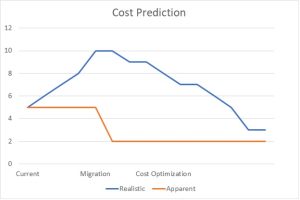Cloud infrastructure. Why?
With public cloud providers expanding their horizons and implementing new features to assist growing businesses, undeniably, they become a competitor for private cloud solutions by eliminating the hassle of maintaining the underlying infrastructure.
Cloud providers have adapted to the generic business needs and now provide key features that usually take considerable amounts of resources to implement on your own.
From a performance standpoint, you’ll find that platforms provide on-demand scalability, with data centers distributed globally even to facilitate latency reduction. Not only that but computing resources can be tailored out of the box to facilitate outstanding application needs. Be it CPU or GPU heavy, IOPS dependent for data manipulation, cloud platforms will only be flexible on those terms.
Performance, however, is not sufficient for a business to be attracted to public cloud solutions. But alongside performance, reliability is also a must, which is why they have strongly invested in ensuring fault tolerance and redundancy for their services to make SLAs as robust as possible.
The list of facilities does not end here. But to move onto another topic of interest for businesses adopting cloud computing platforms, we must first take a step back and remember the limited set of services being offered by cloud providers at first, when they first launched. But with time, the range of services grew outstandingly, helping to improve the productivity of businesses. They’ve become tailored to meet industry standard architectural application designs, with out-of-the-box functionality ensured. On top of that, they make new technologies seem easily reachable as they adopt tools to facilitate the use of, for instance, blockchain or machine learning technology, as keeping up with industry developments is something that catches the eye of growing businesses.
All of this would not be possible without a key focus on security. To help strengthen your organization’s security posture, cloud platforms adhere to strict compliance standards, enforcing security policies and providing features to help you meet your security goals.
All this shiny technology, however, comes at a cost. Make no mistake; it’s easy to get caught up in the public cloud world without not paying attention to what or how you’re consuming capital expenses. However, cloud platforms provide a means to optimize costs. They benefit from the economies of scale that offer them lower infrastructure costs (data centers, hardware, electrical power), which in turn gives them the possibility of offering competitive prices. Whether you opt for the pay-as-you-go on some resources or reserve others upfront for longer amounts of time, there are several pricing models that you can adhere to individually to ensure you minimize costs.
Top ways to reduce costs
Infrastructure assessment
When adopting cloud technologies, such an assessment is the first and probably most crucial step you’ll need to take. An introspective look into your backyard can provide you with several items you’ll need to decide. Which assets are you going to keep, and which assets are you going to retire? Getting rid of resources that aren’t used will save enough in the long run.
Getting a good overview of the assets can allow you to increase the density on top of the underlying infrastructure, therefore lowering overall costs.
Observability
Be it application metrics or financial ones, it’s paramount to keep a close eye on the feedback that the application is throwing your way. Traditionally, you’ll see things like features that are more utilized compared to others or performance indicators that can expose potential issues. More importantly, you’ll have the chance to see how dense your infrastructure is. You can then make the decision to resize your assets accordingly to facilitate the needs of your application and subsequently reduce infrastructure costs.
Influenced by the data you get, you can then move on to configuring auto-scaling on resources that are proven to be bottlenecks while enforcing limits correctly to avoid heavy spikes in costs.
On top of that, cloud providers offer FinOps services which provide you with insights on how your expenses are being distributed. Coupled with the information you have from the application observability stack, FinOps will end up tilting your decision-making process the right way around.
Automation
Infrastructure-as-Code (IaC), GitOps, and CI/CD pipelines with fast feedback mechanisms can significantly lower costs in public cloud platforms by promoting efficiency and cost optimization.
By using IaC, organizations can automate the provisioning and management of cloud resources, ensuring that infrastructure is precisely configured and only allocated when necessary. This eliminates manual errors and prevents over-provisioning, resulting in cost savings through resource optimization. GitOps, in combination with IaC, allows for version-controlled infrastructure changes, enabling teams to track alterations, roll back to previous configurations if issues arise, and maintain consistency across environments, reducing the risk of costly misconfigurations.
CI/CD pipelines with fast feedback mechanisms enhance development and deployment workflows, enabling teams to catch and rectify issues early in the software development lifecycle. This proactive approach minimizes the chances of deploying faulty code or configurations that could lead to downtime or additional cloud costs caused by emergency fixes. Additionally, the automation and rapid feedback loop of CI/CD pipelines speed up the delivery of new features and improvements, allowing businesses to innovate faster and, in turn, optimize costs through increased operational efficiency.
Common misconceptions
The one-size-fits-all solution
In their journey to better modern infrastructure, many believed that the cloud was a universal solution, capable of effortlessly accommodating any application. The allure of this misconception was tempting, for it promised simplicity in a complex world.
However, the reality they faced was more nuanced. Cloud suitability depends on the nature of the application. While the cloud indeed offered versatility, not all applications thrived there equally. Architects soon discovered that considerations such as application architecture, scalability requirements, and data management dictated the cloud’s appropriateness.
Guaranteed cost savings
 As they ventured further, organizations imagined that cloud migration was a guaranteed path to cost savings. This misconception carried an alluring promise of economic efficiency.
As they ventured further, organizations imagined that cloud migration was a guaranteed path to cost savings. This misconception carried an alluring promise of economic efficiency.
Yet, reality proved more intricate. The cloud’s cost dynamics were fluid, often defying expectations. Without meticulous planning, optimization strategies, and continuous monitoring, cloud costs could spiral out of control. The key lay in crafting a cloud strategy that aligned with specific organizational objectives, leveraging tools for cost analysis, and right-sizing resources to avoid wastage.
Instant performance improvement
Enthralled by the prospect of immediate performance upgrades, organizations believed that a simple migration to the cloud would deliver this boon.
However, the world of cloud computing wasn’t bound by magic spells. Application performance in the cloud hinges on various factors, including the application’s architecture, network connectivity, database configurations, and the capabilities of the chosen cloud provider. Achieving desired performance required meticulous design and optimization, not just a change in location.
Improved security
The allure of improved security in public cloud platforms can sometimes create an illusion of invulnerability. While it’s true that cloud providers invest heavily in security measures and offer robust tools and services, the responsibility for securing cloud resources ultimately lies with the customer. This illusion arises from the misconception that once data migrates to the cloud, all security concerns vanish. In reality, cloud security is a shared responsibility, and organizations must still implement proper access controls, encryption, monitoring, and compliance measures to protect their data. Overreliance on the cloud provider’s security can lead to complacency, leaving vulnerabilities unaddressed and potentially exposing organizations to security breaches. Therefore, it’s crucial for businesses to view cloud security as a collaborative effort, where they actively engage in securing their cloud environments to complement the security measures provided by the cloud provider.
No application changes required
Lastly, the adventurers expected a seamless migration, believing that their applications could thrive in the cloud without modification.
Yet, the reality unveiled a subtler truth. While cloud providers endeavored to maintain compatibility, certain application components or dependencies needed adjustments to fully harness cloud capabilities. These modifications ranged from adapting network configurations to leveraging cloud-native services for optimal performance and efficiency.
In their journey through the cloud, these organizations discovered that separating cloud myths from cloud realities required not just vision but a firm grasp of technical nuances. To succeed in their quest for a robust cloud infrastructure, they embraced these realities, armed with technical expertise and a commitment to fine-tune their cloud deployments for maximum benefit.
Small steps with a big impact
In our journey to optimize cloud infrastructure costs, we’ll recommend some small yet impactful actions and decisions. These seemingly modest steps can wield a substantial influence on the overall effectiveness of your cloud strategy, paving the way for sustainable success.
Embracing a team-friendly technology stack
One of the cornerstone principles is recognizing that the best technology stack is one that resonates with your team’s comfort and proficiency. A technology stack that aligns with your team’s skills and preferences fosters a more productive and collaborative environment.
The cloud: a tool, not a magic solution
The cloud, often shrouded in mystique, is fundamentally a tool in your technological stack. Like any tool, its efficacy hinges on tailoring it to your unique business needs. While the cloud can yield remarkable results, it should be integrated into your infrastructure in a way that aligns seamlessly with your organizational goals.
No enchantment in the application: industry best practices matter
A pivotal aspect of crafting a robust infrastructure is the recognition that an exemplary application is a prerequisite. To build a proper infrastructure, it’s imperative to adhere to industry best practices. Your application should follow these standards, serving as the foundation upon which your infrastructure stands.
Centering infrastructure around the application
In the quest for efficiency, the infrastructure must be designed with a laser focus on the application’s specific needs and intricacies. An application-centered approach ensures that your infrastructure seamlessly accommodates the unique demands of your software.
Steadfast commitment to standards
Lastly, in this ever-evolving landscape of technology, it’s crucial to acknowledge that nothing remains static. Every shiny, de facto standard tool we embrace today will eventually face obsolescence. As stewards of technological progress, our commitment to adhering to evolving standards ensures the adaptability and longevity of our infrastructure.
By Alex Coman,
Software Architect
STAY TUNED
Subscribe to our newsletter today and get regular updates on customer cases, blog posts, best practices and events.











